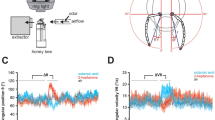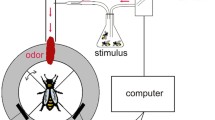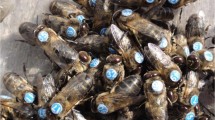Abstract
Bees captured at the feeding site were released either at a novel site or at the site at which they had been captured. Containers used during transport were either open or covered, thus allowing or preventing, respectively, free view of the panorama. Shortly before release, each bee, regardless of the covering mode used during displacement, was either (i) granted a view of the release site, (ii) allowed to see only overall brightness by covering the container with translucent drawing paper, or (iii) denied any view of the release site. Orientation flights performed by each bee upon release were recorded. Irrespective of whether they had been transported in open or covered containers, bees granted a view of the release site prior to release usually flew away without performing orientation flights, whereas bees prevented from viewing the release site performed intensive orientation flights. An intermediate intensity of orientation flights was displayed by bees leaving translucent containers. Assuming that the intensity of orientation flight is a measure of the state of orientation of the released bee, we conclude that view of the release site, but not view of the environment during displacement, is crucial for orientation.
Similar content being viewed by others
References
Collett TS (1995) Making learning easy: The acquisition of visual information during the orientation flights of social wasps. J Comp Physiol A 177: 737–747
Frisch Kv (1967) The dance language and orientation of bees. Harvard Univ Press, Cambridge Mass
Geiger K, Kratzsch D, Menzel R (1994) Bees do not use landmark cues seen during displacement for displacement compensation. Naturwissenschaften 81: 415–417
Iersel JJA, van, Assem J van den (1964) Aspects of orientation in the digger wasp Bembix rostrata. Anim Behav Suppl 1: 145–162
Lehrer M (1991) Bees which turn back and look. Naturwissenschaften 78: 274–276
Lehrer M (1993) Why do bees turn back and look? J Comp Physiol 172: 544–563
Lehrer M (1996) Small-scale navigation in the honeybee — active acquisition of visual information about the goal. J Exp Biol 199: 253–261
Lehrer M, Collett TS (1994) Approaching and departing bees learn different cues to the distance of a landmark. J Comp Physiol A 175: 171–177
Menzel R, Chittka L, Eichmüller S, Geiger K, Peitsch D, Knoll P (1990) Dominance of celestial cues over landmarks disproves map-like orientation in honey bees. Z Naturforsch 45c: 723–726
Menzel R, Geiger K, Chittka L, Joerges J, Kunze J, Muller U (1996) The knowledge-base of bee navigation. J Exp Biol 199: 141–146
Opfinger E (1931) Über die Orientierung der Biene an der Futterquelle. Z Vergl Physiol 15: 431–487
Schöne H (1995) Take-off behavior and vanishing bearings of honeybees after displacement with open view or in a sight-proof box. Naturwissenschaften 82: 343–345
Schöne H, Harris AC, Schöne H, Mahalski PA (1993a) Homing after displacement in open or closed containers by the digger wasp Argogorytes carbonarius (Hymenoptera, Sphecidae). Ethology 95: 152–156
Schöne H, Tengö J, Kühme D, Schöne H, Kühme L (1993b) Homing with or without sight during displacement in the digger wasp Bembix rostrata (Hymenoptera, Sphecidae). Ethol Ecol Evol 5: 549–552
Ugolini A (1985) Initial orientation and homing in workers of Polistes gallicus (L.) Z Tierpsychol 69: 133–140
Ugolini A, Cannicci S (1995) Homing in paper-wasps. In: Turillazzi S, West-Eberhard MJ (ed) Natural history and evolution of paper-wasps. Oxford Univ Press, Oxford New York Tokio, pp126–146
Ugolini A, Samoggia M (1991) Workers of Polistes dominulus (Christ): influence of the landscape on initial orientation. Ethol Ecol Evol 3: 247–255
Vollbehr J (1975) Zur Orientierung junger Honigbienen bei ihrem ersten Orientierungsflug. Zool Jb Physiol 79: 33–65
Wehner R (1981) Spatial vision in arthropopds. In: Autrum H (ed) Vision in invertebrates Hdb Sens Physiol VII/6 C. Springer, Berlin Heidelberg New York, pp 287–616
Wehner R (1987) ‘Matched filters’ — neural models of the external world. J Comp Physiol A 161: 511–531
Wolf E (1926) Über das Heimkehrvermögen der Bienen. Z Vergl Physiol 3: 615–691
Zeil J (1993) Orientation flights of solitary wasps (Cerceris, Sphecidae; Hymenoptera). I. Description of flight. J Comp Physiol A 172: 189–205
Zeil J, Kelber A, Voss R (1996) Structure and function of learning flights in bees and wasps. J Exp Biol 199: 245–252
Author information
Authors and Affiliations
Additional information
Dedicated to Wolfgang Wickler on occasion of the 65th anniversary of his birthday.
Rights and permissions
About this article
Cite this article
Schöne, H. Orientation flight behavior in honeybees released from open or covered containers — after or without displacement. J Comp Physiol A 179, 593–597 (1996). https://doi.org/10.1007/BF00192325
Accepted:
Issue Date:
DOI: https://doi.org/10.1007/BF00192325




